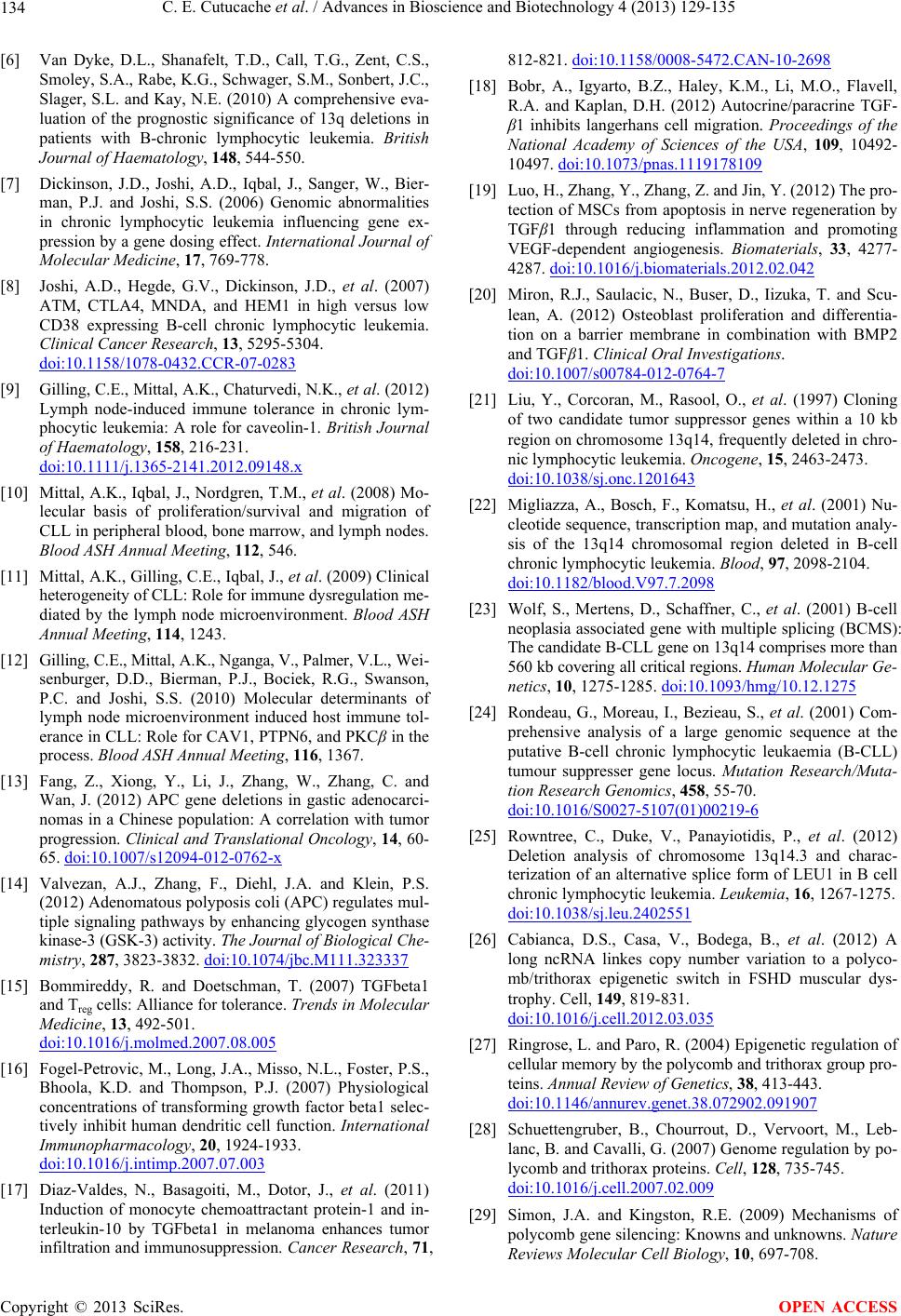
C. E. Cutucache et al. / Advances in Bioscience and Biotechnology 4 (2013) 129-135
134
[6] Van Dyke, D.L., Shanafelt, T.D., Call, T.G., Zent, C.S.,
Smoley, S.A., Rabe, K.G., Schwager, S.M., Sonbert, J.C.,
Slager, S.L. and Kay, N.E. (2010) A comprehensive eva-
luation of the prognostic significance of 13q deletions in
patients with B-chronic lymphocytic leukemia. British
Journal of Haematology, 148, 544-550.
[7] Dickinson, J.D., Joshi, A.D., Iqbal, J., Sanger, W., Bier-
man, P.J. and Joshi, S.S. (2006) Genomic abnormalities
in chronic lymphocytic leukemia influencing gene ex-
pression by a gene dosing effect. International Journal of
Molecular Medicine, 17, 769-778.
[8] Joshi, A.D., Hegde, G.V., Dickinson, J.D., et al. (2007)
ATM, CTLA4, MNDA, and HEM1 in high versus low
CD38 expressing B-cell chronic lymphocytic leukemia.
Clinical Cancer Research, 13, 5295-5304.
doi:10.1158/1078-0432.CCR-07-0283
[9] Gilling, C.E., Mittal, A.K., Chaturvedi, N.K., et al. (2012)
Lymph node-induced immune tolerance in chronic lym-
phocytic leukemia: A role for caveolin-1. British Journal
of Haematology, 158, 216-231.
doi:10.1111/j.1365-2141.2012.09148.x
[10] Mittal, A.K., Iqbal, J., Nordgren, T.M., et al. (2008) Mo-
lecular basis of proliferation/survival and migration of
CLL in peripheral blood, bone marrow, and lymph nodes.
Blood ASH Annual Meeting, 112, 546.
[11] Mittal, A.K., Gilling, C.E., Iqbal, J., et al. (2009) Clinical
heterogeneity of CLL: Role for immune dysregulation me-
diated by the lymph node microenvironment. Blood ASH
Annual Meeting, 114, 1243.
[12] Gilling, C.E., Mittal, A.K., Nganga, V., Palmer, V.L., Wei-
senburger, D.D., Bierman, P.J., Bociek, R.G., Swanson,
P.C. and Joshi, S.S. (2010) Molecular determinants of
lymph node microenvironment induced host immune tol-
erance in CLL: Role for CAV1, PTPN6, and PKCβ in the
process. Blood ASH Annual Meeting, 116, 1367.
[13] Fang, Z., Xiong, Y., Li, J., Zhang, W., Zhang, C. and
Wan, J. (2012) APC gene deletions in gastic adenocarci-
nomas in a Chinese population: A correlation with tumor
progression. Clinical and Translational Oncology, 14, 60-
65. doi:10.1007/s12094-012-0762-x
[14] Valvezan, A.J., Zhang, F., Diehl, J.A. and Klein, P.S.
(2012) Adenomatous polyposis coli (APC) regulates mul-
tiple signaling pathways by enhancing glycogen synthase
kinase-3 (GSK-3) activity. The Journal of Biological Che-
mistry, 287, 3823-3832. doi:10.1074/jbc.M111.323337
[15] Bommireddy, R. and Doetschman, T. (2007) TGFbeta1
and Treg cells: Alliance for tolerance. Trends in Molecular
Medicine, 13, 492-501.
doi:10.1016/j.molmed.2007.08.005
[16] Fogel-Petrovic, M., Long, J.A., Misso, N.L., Foster, P.S.,
Bhoola, K.D. and Thompson, P.J. (2007) Physiological
concentrations of transforming growth factor beta1 selec-
tively inhibit human dendritic cell function. International
Immunopharmacology, 20, 1924-1933.
doi:10.1016/j.intimp.2007.07.003
[17] Diaz-Valdes, N., Basagoiti, M., Dotor, J., et al. (2011)
Induction of monocyte chemoattractant protein-1 and in-
terleukin-10 by TGFbeta1 in melanoma enhances tumor
infiltration and immunosuppression. Cancer Research, 71,
812-821. doi:10.1158/0008-5472.CAN-10-2698
[18] Bobr, A., Igyarto, B.Z., Haley, K.M., Li, M.O., Flavell,
R.A. and Kaplan, D.H. (2012) Autocrine/paracrine TGF-
β1 inhibits langerhans cell migration. Proceedings of the
National Academy of Sciences of the USA, 109, 10492-
10497. doi:10.1073/pnas.1119178109
[19] Luo, H., Zhang, Y., Zhang, Z. and Jin, Y. (2012) The pro-
tection of MSCs from apoptosis in nerve regeneration by
TGFβ1 through reducing inflammation and promoting
VEGF-dependent angiogenesis. Biomaterials, 33, 4277-
4287. doi:10.1016/j.biomaterials.2012.02.042
[20] Miron, R.J., Saulacic, N., Buser, D., Iizuka, T. and Scu-
lean, A. (2012) Osteoblast proliferation and differentia-
tion on a barrier membrane in combination with BMP2
and TGFβ1. Clinical Oral Investigations.
doi:10.1007/s00784-012-0764-7
[21] Liu, Y., Corcoran, M., Rasool, O., et al. (1997) Cloning
of two candidate tumor suppressor genes within a 10 kb
region on chromosome 13q14, frequently deleted in chro-
nic lymphocytic leukemia. Oncogene, 15, 2463-2473.
doi:10.1038/sj.onc.1201643
[22] Migliazza, A., Bosch, F., Komatsu, H., et al. (2001) Nu-
cleotide sequence, transcription map, and mutation analy-
sis of the 13q14 chromosomal region deleted in B-cell
chronic lymphocytic leukemia. Blood, 97, 2098-2104.
doi:10.1182/blood.V97.7.2098
[23] Wolf, S., Mertens, D., Schaffner, C., et al. (2001) B-cell
neoplasia associated gene with multiple splicing (BCMS):
The candidate B-CLL gene on 13q14 comprises more than
560 kb covering all critical regions. Human Molecular Ge-
netics, 10, 1275-1285. doi:10.1093/hmg/10.12.1275
[24] Rondeau, G., Moreau, I., Bezieau, S., et al. (2001) Com-
prehensive analysis of a large genomic sequence at the
putative B-cell chronic lymphocytic leukaemia (B-CLL)
tumour suppresser gene locus. Mutation Research/Muta-
tion Research Genomics, 458, 55-70.
doi:10.1016/S0027-5107(01)00219-6
[25] Rowntree, C., Duke, V., Panayiotidis, P., et al. (2012)
Deletion analysis of chromosome 13q14.3 and charac-
terization of an alternative splice form of LEU1 in B cell
chronic lymphocytic leukemia. Leukemia, 16, 1267-1275.
doi:10.1038/sj.leu.2402551
[26] Cabianca, D.S., Casa, V., Bodega, B., et al. (2012) A
long ncRNA linkes copy number variation to a polyco-
mb/trithorax epigenetic switch in FSHD muscular dys-
trophy. Cell, 149, 819-831.
doi:10.1016/j.cell.2012.03.035
[27] Ringrose, L. and Paro, R. (2004) Epigenetic regulation of
cellular memory by the polycomb and trithorax group pro-
teins. Annual Review of Genetics, 38, 413-443.
doi:10.1146/annurev.genet.38.072902.091907
[28] Schuettengruber, B., Chourrout, D., Vervoort, M., Leb-
lanc, B. and Cavalli, G. (2007) Genome regulation by po-
lycomb and trithorax proteins. Cell, 128, 735-745.
doi:10.1016/j.cell.2007.02.009
[29] Simon, J.A. and Kingston, R.E. (2009) Mechanisms of
polycomb gene silencing: Knowns and unknowns. Nature
Reviews Molecular Cell Biology, 10, 697-708.
Copyright © 2013 SciRes. OPEN ACCESS